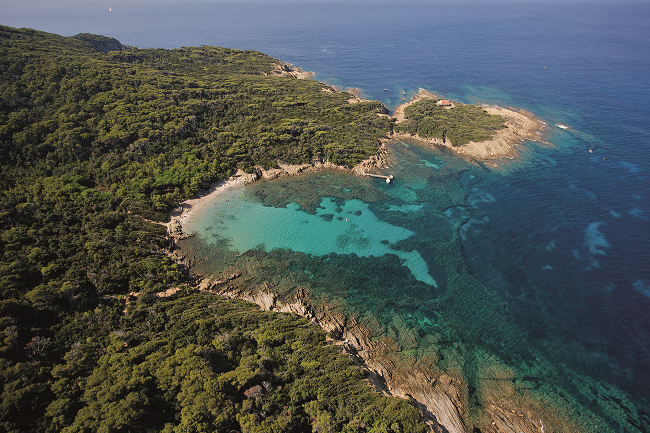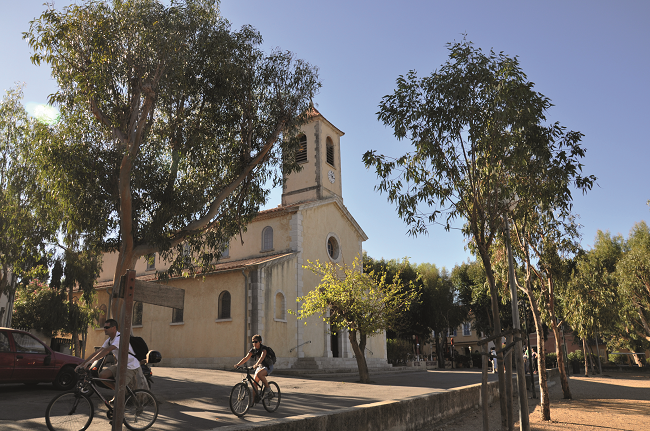Hyères, the Original French Riviera

Dubbed the original Riviera, Hyères is just as imbued with history, art and fabulous architecture as it is with natural beauty.
It’s golden hour but I’m seeing pink. We’re driving along a narrow strip of land surrounded by salt marshes and wild bamboo when a mirage-like vision distracts me from the sunset: a cluster of graceful rose-coloured flamingos, who raise their slender necks to gaze disinterestedly at us, then dip their beaks back in the shallow waters for more crustacean-nibbling.
An ordinary sight in the Camargue, perhaps, but we are further east, technically on the French Riviera, the land of seafront palaces and over-development, where ‘wild’ usually conjures frenzied parties. Here, on the Giens peninsula – an under-the-radar paradise of salt flats, pine forests and pristine sandy beaches, fiercely protected by the National Park of Port-Cros – all is intensely quiet.
A haven for writers
A district of Hyères, the ‘City of Palms’, Giens is just one of many reasons why this Rivera town is unique. With a new surge of stylish and sustainable beach hotels, contemporary art museums and a modernist hub for fashion and design, the city offers an eclectic mix of bling-free pleasures for nature lovers, aquanauts, art aficionados and authenticity-craving foodies.
It wasn’t always that way. Over a century ago, Hyères was a sun-drenched winter resort for the crowned heads of Europe and ailing aristocrats, and was deserted in the summertime, “I was only happy once; that was at Hyères,” wrote Robert Louis Stevenson, who spent 16 months in La Solitude, a pseudo-Swiss chalet perched on a bluff overlooking the sea, where he wrote A Child’s Garden of Verse. Other writers, from Edith Wharton to André Gide, followed suit. But perhaps the most radical change occurred in 1923, when Marie-Laure Bischoffsheim, a young heiress from one of the wealthiest banking families in France, married aristocrat Charles de Noailles and received a plot of land for a vacation home in Hyères as a wedding present.

© Julien Veyssade
It wasn’t long before their modernist Mallet-Stevens-designed villa – where the patron-of-the-arts couple lavishly entertained the likes of Dalí, Man Ray, Buñuel, Giacometti and Poulenc – would become the unlikely hotbed for the avant-garde. Now, exactly a century later, the Villa Noailles is still going strong and this year, to mark the centenary, it is hosting an exceptional year of cutting-edge art and design exhibitions, including the International Design Parade Festival and the International Festival of Fashion, Photography and Accessories, to be held in October, where major fashion houses and young designers will reinvent Marie-Laure’s extravagant wardrobe.
Similarly, the history of Giens, Hyères’s boot-shaped beachfront finger of land, was marked by another ‘outsider’ – renowned Parisian and automobile-maker Louis Renault, who in 1928 fell in love with the untamed tropical vegetation and bought a sprawling 25-hectare property, Escampobar, at the tip of the peninsula by the Port du Niel, a tiny fishing port which he helped restore with his own funds. Today, nothing remains of Renault’s estate (converted into dozens of villas, the main house is now where the Hôtel Provençal stands). Still, not much has changed; the postcard-perfect port where Renault kept his yachts is still a timeless spot for freshly-caught seafood and fish soup.

Villa Noailles © OTPM
Postcard-perfect port
And these days, there are lots of things to do and see in the once-sleepy neighborhood of Giens. Overlooking the fisherman’s port, the new museum, Musée du Niel, is hosting its inaugural exhibition ‘Les Chemins de l’Abstraction’ on Post-War Abstract Art, featuring a group of rarely-exhibited French artists as well as celebrated master Pierre Soulages.
If you’re dreaming of a beachfront hotel, there are a number of terrific choices, from charmingly funky to stylishly affordable, plus the latest upscale addition to Hyères’ offerings – five-star eco-lodge Le Hameau des Pesquiers, literally yards from sea in La Capte district. Bird-watchers, rejoice: bordered by a protected pine forest, you might catch a glimpse of some of the 300 species twittering away on your morning stroll or bike ride.
When you arrive at 48-room Le Hameau des Pesquiers, the first thing you notice is the unusual and prettily restored hamlet of houses – between 1806 and 1900 the property housed the buildings of the Salin du Midi, plus the salt-workers and their families. Rescued from ruin after 20 years of abandonment, the new owners, the Lelièvre family, have reinvented the historic structures to accommodate guests – the 1803-built Clock Building is the bar and restaurant, and there’s a lovely ochre chapel where mass is still held on Sundays. In keeping with the biodiversity ethic, there’s everything from an organic vegetable garden (with a compost heap, naturally) and citrus grove to bee hives (yes, the honey at breakfast has been produced just steps away) and the wild untamed landscape. The Nuxe Spa has an indoor pool, but chances are you’ll be spending time on the beach, just behind a wooden gate. The spacious rooms (think neo-rustic with exposed wooden beams), have private terraces, and some have Jacuzzis too.

Le Hameau des Pesquiers’ spa © Lanie Goodman
A low-key seaside vibe prevails at the seriously eco-friendly hotel Almanarre Plage, right across from the beach, where you’ll find a mix of sea cyclists, windsurfers and other water sports enthusiasts, who come for the ideal location and delicious, generous breakfasts (don’t be put off by the list of rules – it’s all very well-intentioned).
The list goes on: Lido Beach, a shabby chic restaurant-hotel ; Le Lodge des Îles d’Or, a 22-room boutique hotel with tropical atmosphere galore and a lush garden ; Hôtel Reine Jane, the most eclectic of the offerings, featuring 14 artist-designed rooms, yoga classes on the roof and a delicious Sunday brunch. Finally, the family-run Hôtel Provençal, set back on a lovely village square, has undergone a spruce-up, but still has a timeless vibe and a dreamy sea-water rock pool.
The local restaurant scene excels in unpretentious tasty terroir dishes that won’t break the bank: Denti for fish, the canteen-style Le Kiosque for homemade snacks, or the lively brasserie Guillaume Tell (which serves breakfast at 6.30am and dinner until midnight), or the new bistro, l’Enoteca, boasting a menu that showcases the finest local ingredients.

Breakfast at Almanarre Plage © Lanie Goodman
Art and wine
No one leaves Hyères without a day trip on the ferry to the island of Porquerolles, where nature, award-winning wine and contemporary art are celebrated at the Villa Carmignac. Continue the art trail at the recently rehabilitated Banque de France, La Banque, featuring 20th-century local artists and culture, then head for the palm-shaded heights to Costabelle, where the privately-owned estate Villa Magdala (once the home of English aristocrats), has now opened its doors for seasonal art shows.
“This spot, our garden, and our view, are sub-celestial”, wrote Stevenson. And chances are that even a century later – as you gaze out at the sea and the Golden Islands, bathed in a silvery light – you’ll be inclined to rhapsodise about the singular charm of the Riviera’s last wild frontier.
From France Today Magazine

Porquerolles church © OTPM
Lead photo credit : ©Lanie Goodman
Share to: Facebook Twitter LinkedIn Email
More in coastal towns of France, Côte d'Azur, French coast, Mediterranean coast, Riviera, South of France
Leave a reply
Your email address will not be published. Required fields are marked *



